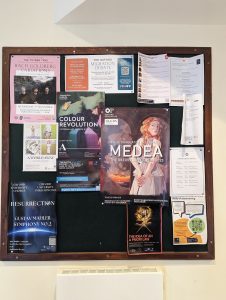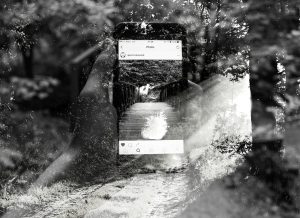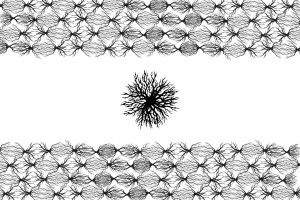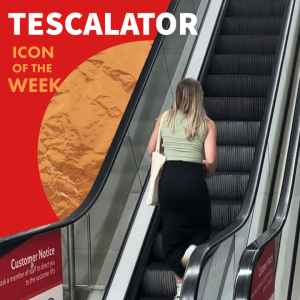Why Do We Like Drawing Naked People?
by Bella Gerber-Johnstone | January 19, 2024
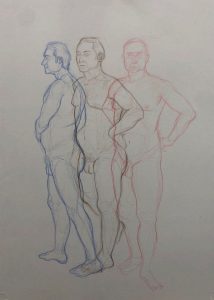
I looked down at my paper and blushed. My pencil had jutted enthusiastically across the page, and I had drawn a disproportionately large carrot-like shape hanging between his legs. I was in my first-ever life drawing class.
Oxford noticeboards are overwhelmed with leaflets advertising life drawing classes. If you really want to, and have a fiver to spare each evening, you could rock up to a different class every day of the week. That’s a grand total of 63 naked bodies to sketch each term.
It was a Thursday afternoon. I stumbled into a room filled with people sitting cross-legged, paper poised on their knees, jazz playing slowly in the background. I was overwhelmed by the newness of it all, and a bit sweaty from cycling there.
A male student walked out with a white towel wrapped around his waist. He let it drop to the floor and we were off: five minutes on one pose, ten on the next. Instructions swirled around my head: try without lifting your pencil off the page; now, if you’re comfortable, a pose facing the front; and finally, a detailed drawing.
The model’s body turned into a series of squares and circles on my page. His head looked far too large and his thighs far too long – I just couldn’t get the proportions right. I was getting flustered about letting my sketches veer anywhere near Groin Territory. I didn’t want anyone to think I was over-focusing on his penis (and, worse, I didn’t want anyone to think that I was afraid to draw a penis).
The girl next to me wasn’t helping matters. She had an infuriatingly composed air about her: her pencils lined up in a little metal tin, she was effortlessly copying his physique onto the leather-bound sketchbook in front of her. She was acting as a human photocopier. I doubt she was thinking about sex.
I wanted to master the skill of drawing naked people without carrot-shaped mishaps.
So I asked Naomi Bull, who studies at Glasgow School of Art what the secret is. She sees life drawing as a key part of her practice. When she was 15, she went to her first class at the National Gallery. There she was told the key is to “always start at the centre of the body”. She swears by that now: “Wherever the centre is, find it”. It might be the navel, it might be the small of the back, but whatever you do, find it.
Once she’s found the centre, the next step is to draw a line of action, a conceptual tool to show where the body is heading towards. “Whether or not they’re still, it remains a body of movement”, she says.
Up in Glasgow, she’s started a class with six other female students. They take it in turns to model: there’s no pressure to be nude. Naomi sticks to completely clothed modelling. Sometimes she tugs at her shirt to reveal a bit of skin– “it’s more interesting to have different levels of nudity… it adds texture”.
After the class, I cycled back and raved about the freeing experience of drawing a stranger’s curly pubic hair, flaunting my charcoal-covered palms in my friends’ faces. Someone laughed, asked me if life drawing wasn’t “secretly a bit horny”. I laughed too. My cheeks reddened slightly.
Was there really something sexually charged about sketching someone’s genitalia? What is it that we’re so drawn to?
“It’s relaxing,” says Connie Higgins, who runs weekly student-only life drawing classes in Oxford. “You’re able to look at a body in a non-sexual way. To have nakedness and not have the instinct to be immediately sexual – well, it’s remarkable”.
Connie points out life drawing has “a very rare overlap between being interested in welfare and making people feel politically engaged”. Life drawing, it seems, lies in the middle of the Venn diagram of pleasure and politics.
One of the main challenges for Connie is diversifying their models. The worst thing they could do, she tells me, is to target people and say “we want you because we haven’t had someone who looks like you yet”. So her Facebook posts advertise that models can be anyone, and she hopes that this organically leads to a wider range of people and bodies. For models totally new to the experience, one of the biggest surprises is how physically taxing it is: “You are having to hold one pose, naked, for 20 minutes”.
The other day my partner asked me if I’d ever model. My knee-jerk reaction was a hard, hard no. Absolutely not. That’s like asking me to experience a real-life nightmare, I said. You know the one: you show up at school and realise you’re completely naked, and everyone’s laughing at you (and probably pointing at the way one breast is bigger than the other).
Funnily enough, I think it’s less the getting naked that scares me, and more about seeing my body how others see it. What if they spot all the things I scrutinise in the mirror?
Someone who regularly faces those nightmarish fears is a model and fine art student who wants to remain anonymous (let’s call her ‘Bea’ from now on). “I’m quite impulsive,” she admits. “Five minutes in advance I’ll make a decision about how many clothes I’ll take off”.
Bea mentions she’s had a hard time with eating behaviours in the past and she just wanted to “bite the bullet and go in headfirst”. I’m curious to hear how she overcomes critical voices in her head during the session. She shrugs: “I think about what I’m having for dinner that night, I listen to the music.” Then she candidly tells me: “I can’t see myself when I’m modelling, so I can’t critique my body.” I fall quiet.
When I ask Connie if she’d ever model at one of her classes, she tells me she would, but only with her co-leader, Lola: “We’ll do a joint session one day, and we’ll hold hands as we do it”. She feels she’d be most hesitant if her friends came along – a room of anonymous eyes feels safer to her than a room of familiar ones.
But Bea likes the exact opposite: it makes her feel more comfortable being seen by her friends. This way she knows she’s being recognised as a person, as well as a body. Bea draws the line when it comes to modelling for men, however — she says “a lot of the objectification of the female body comes from men”, and she wouldn’t ever feel at ease in the male gaze.
Connie tells me she noticed a number of middle-aged men making a beeline for their stall at the fresher’s fair (“probably to see naked teenagers”). Her group does not allow non-students to register for classes to protect the models’ safety. Before the classes she talks to the models about any worries might have, the most common being the fear of having their photo taken.
Do these concerns mean there’s a potential for attendees to sexualise the models, I ask?
Connie believes the sexualisation, if any, only comes from people who have the intention to sexualise both model and premise. This is underscored by Naomi who tells me “the body only becomes a sexual entity if I’m doing that to it– as the artist”.
Bea tells me about a class that’s stayed with her. On this occasion, she was drawing, not modelling. The model was a woman in her 40s, and at the end of the class, as is often routine, everyone shared their drawings. The model got a little teary-eyed, and told Bea she had drawn a spitting image of not only her, but her mother.
Hearing the testimonies of these models and artists – clothed and unclothed – I find myself on the brink of sending hundreds of emails to every Oxford life drawing group saying I’ll bare all. I’ll do it, I will, I will. Naked or not, it’s a chance to be seen— even if I make someone look down at their page and blush.∎
Words by Bella Gerber-Johnstone. Art courtesy of Angelika Woodruff.
